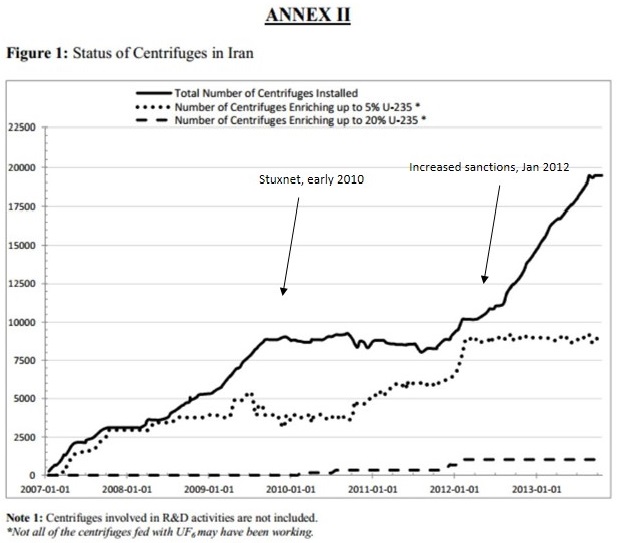IAEA Report Shows Iran Halting Expansion of Nuclear Program — Slowdown Began Before Rouhani Elected
Despite a near-miss last weekend on an agreement between Iran and the P5+1 group of nations, a report released yesterday by the IAEA shows that Iran has already carried out several of the steps that such an agreement would have called for. The news is good enough that Joby Warrick even opens with a hopeful tone:
Iran appears to have dramatically slowed work on its atomic energy program since the summer, U.N. officials said Thursday. The report could add momentum to diplomatic efforts to resolve a decade-old dispute over Iranian nuclear activities.
The report by the International Atomic Energy Agency said Iran all but halted the installation of new centrifuges at its uranium enrichment plants beginning in August, the same month that moderate cleric Hassan Rouhani was sworn in as president. Work on a controversial nuclear reactor also slowed, the U.N. watchdog agency said. Iran continued producing low-enriched uranium, but at a slightly reduced rate, it said.
Similarly, the New Times also finds the report encouraging and associates the improvement with the election of Hassan Rouhani:
President Obama made a vigorous appeal to Congress on Thursday to give breathing space to his efforts to forge a nuclear deal with Iran, and the prospects for an interim agreement may have improved with the release of a report by international inspectors who said that for the first time in years, they saw evidence that the Iranians have put the brakes on their nuclear expansion.
The inspectors, from the International Atomic Energy Agency, said that very few new advanced centrifuges had been installed since President Hassan Rouhani of Iran took office in June, promising a new start with the West, and that little significant progress has been made on the construction of a new nuclear reactor, which became a point of contention in negotiations in Geneva last week.
Note that one of the big pieces of news heralded by the Post and the Times is the halting of installation of new centrifuges. But buried in the back of the report (pdf), in the second annex, is a graph showing the total number of centrifuges installed, the number of centrifuges dedicated to enrichment of uranium up to 5% and the number of centrifuges dedicated to enrichment to 20%. I have reproduced that graph here, but I have added arrows pointing to two major discontinuities in the trends shown in the graph.
The early arrow, where we see a halt of nearly two years in the installation of new centrifuges and a loss of a number of centrifuges enriching to 5%, corresponds very closely to the release of the Stuxnet worm in early 2010 (although it looks like the loss of functioning centrifuges may have been in late 2009, so the actual release most likely was around that time).
IAEA graph of Iran centrifuge operation over time. I have added arrows for the release of the Stuxnet worm and imposition of stronger sanctions.
Beginning in early 2011, Iran put more of its installed centrifuges into operation for enrichment to 5% and continued at a fairly steady pace throughout much of the year. At the beginning of 2012, the US and EU imposed much stronger sanctions on Iran. Although Iran did put some centrifuges into operation for enrichment to 20% around that same time, this graph shows that even though Iran restarted installation of new centrifuges in 2012, no additional centrifuges have been put into service for enrichment to either 5% or 20% since early 2012. This capping of enrichment capacity that is in actual operation has rarely, if ever, been noted in the press. Significantly, it predates Rouhani’s election by over a year. Perhaps it is a sign that the sanctions were effective in getting Iran to put the brakes on their program. Alternatively, it might suggest that Iran knew where Israel’s “red line” would be (a stockpile of around 200 kg of 20% enriched uranium might be enough to make a bomb after further enrichment) and made sure that the approach to this line would be slow. They also delayed its onset by converting some of the 20% enriched uranium to fuel plates so that it would be less readily subjected to further enrichment under a “breakout” scenario.
The halting of new centrifuge installation shows up in the graph, where we see the installed centrifuge line level off in the middle of this year, but this seems less dramatic than stopping the process of putting installed centrifuges into use for enrichment.
When we realize that significant steps were taken to slow advancement of Iran’s nuclear program before Rouhani was elected, it becomes easier to understand why his “moderate” stance and willingness to enter into negotiations have not met with significant resistance from Iran’s Supreme Leader Ali Kahmenei and other leading clerics.

